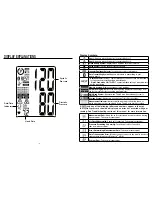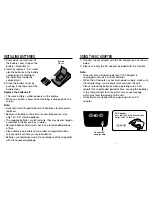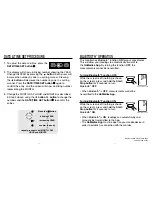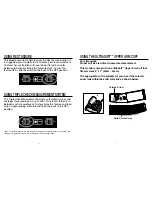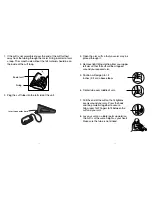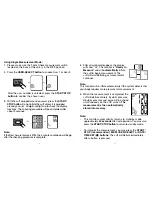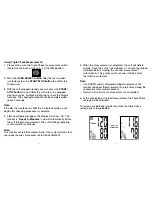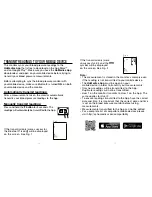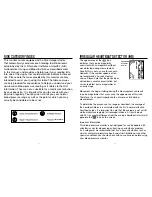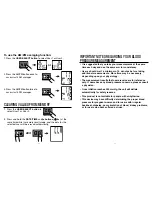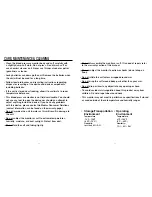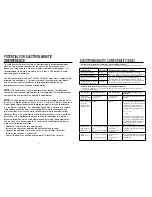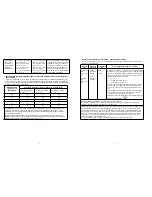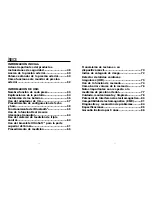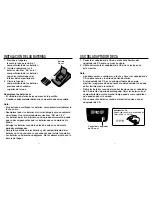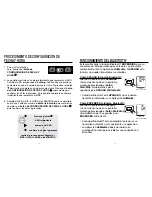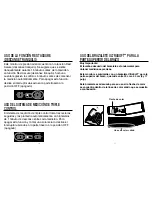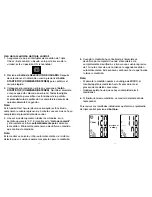
38
39
• Recommended separation distances between portable and mobile RF communication equipment
and the device.
The device is intended for use in an electromagnetic environment where radiated RF disturbances are
under control. User can help prevent electromagnetic interference by keeping the device at a minimum
distance from portable and mobile RF communications equipment (transmitters). Below table details the
maximum output power of transmitter:
Rated maximum
output power of
transmitter W
Separation distance according to frequency of transmitter m
150 kHz to 80 MHz
d = 1.2
80 MHz to 800 MHz
d = 1.2
800 MHz to 2.5 GHz
d = 2.3
0.01
0.12
0.12
0.23
0.1
0.38
0.38
0.73
1
1.2
1.2
2.3
10
3.8
3.8
7.3
100
12
12
23
For transmitters rated at a maximum output power not listed above, the recommended separation
distance d in metres (m) can be estimated using the equation applicable to the frequency of the
transmitter, where P is the maximum output power rating of the transmitter in watts (W) according to
the transmitter manufacturer.
NOTE 1 At 80 MHz and 800 MHz, the separation distance for the higher frequency range applies.
NOTE 2 These guidelines may not apply in all situations. Electromagnetic propagation is affected by
absorption and reflection from structures, objects and people.
• Guidance and manufacturer’s declaration – electromagnetic immunity
The device is intended for use in the electromagnetic environments listed below, and should only be
used in such environments:
Immunity
test
IEC 60601
test level
Compliance
level
Electromagnetic environment – guidance
Conducted
RF
IEC 61000-
4-6
Radiated
RF
IEC 61000-
4-3
3 Vrms
150 kHz to
80 MHz
3 V/m
80 MHz to
2.5 GHz
6 Vrms
10 V/m
Portable and mobile RF communications equipment should
be used no closer to any part of the device, including cables,
than the recommended separation distance calculated from
the equation applicable to the frequency of the transmitter.
Recommended separation distance
d = 1.2
d = 1.2 80 MHz to 800 MHz
d = 2 .3 800 MHz to 2.5 GHz
where P is the maximum output power rating of the transmit-
ter in watts (W) according to the transmitter manufacturer
and d is the recommended separation distance in metres
(m).
Field strengths from fixed RF transmitters, as determined by
an electromagnetic site survey, a should be less than the
compliance level in each frequency range.b
Interference may occur in the vicinity of equipment marked
with the following symbol:
NOTE 1 At 80 MHz and 800 MHz, the higher frequency range applies.
NOTE 2 These guidelines may not apply in all situations. Electromagnetic propagation is affected by
absorption and reflection from structures, objects and people.
a Field strengths from fixed transmitters, such as base stations for radio (cellular/cordless) telephones and
land mobile radios, amateur radio, AM and FM radio broadcast and TV broadcast cannot be predicted
theoretically with accuracy. To assess the electromagnetic environment due to fixed RF transmitters, an
electromagnetic site survey should be considered. If the measured field strength in the location in which
the device is used exceeds the applicable RF compliance level above, the device should be observed to
verify normal operation. If abnormal performance is observed, additional measures may be necessary,
such as reorienting or relocating the device.
b Over the frequency range 150 kHz to 80 MHz, field strengths should be less than 3 V/m.
interruptions
and voltage
variations on
power supply
input lines
IEC 61000-4-11
<5 % UT (>95 % dip in
UT) for 0,5 cycle
40 % UT (60 % dip in
UT) for 5 cycles
70 % UT (30 % dip in
UT) for 25 cycles
<5 % UT (>95 % dip in
UT) for 5 sec
<5 % UT (>95 % dip
in UT) for 0,5 cycle
40 % UT (60 % dip in
UT) for 5 cycles
70 % UT (30 % dip in
UT) for 25 cycles
<5 % UT (>95 % dip
in UT) for 5 sec
Mains power quality should be that
of a typical commercial or hospital
environment. If the user of the de-
vice requires continued operation
during power mains interruptions,
it is recommended that the device
be powered from an uninterruptible
power supply or a battery.

